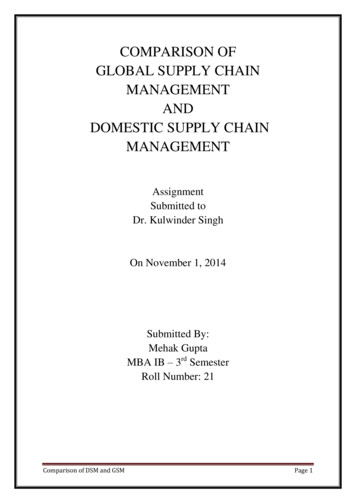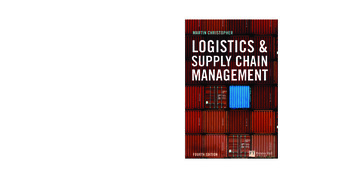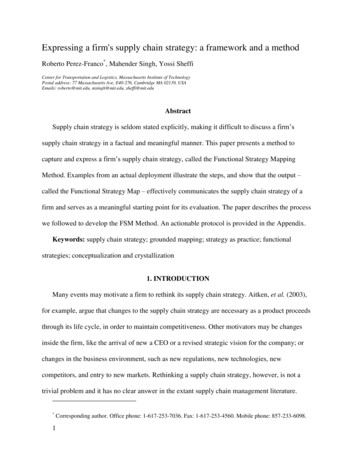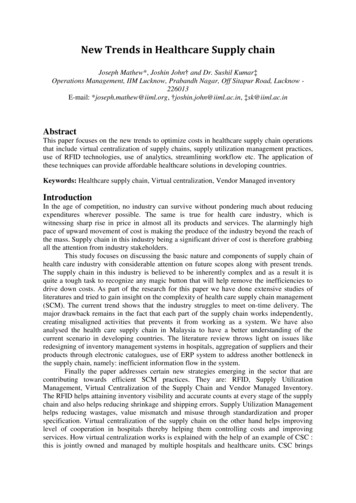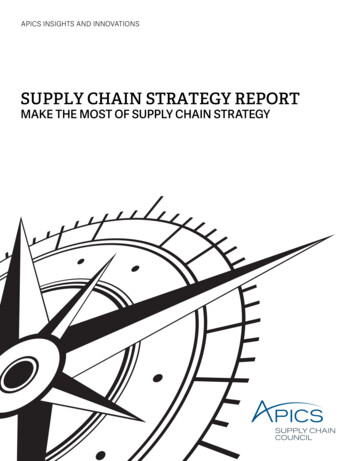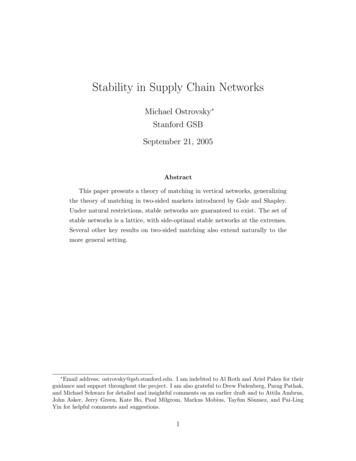
Transcription
Stability in Supply Chain NetworksMichael Ostrovsky Stanford GSBSeptember 21, 2005AbstractThis paper presents a theory of matching in vertical networks, generalizingthe theory of matching in two-sided markets introduced by Gale and Shapley.Under natural restrictions, stable networks are guaranteed to exist. The set ofstable networks is a lattice, with side-optimal stable networks at the extremes.Several other key results on two-sided matching also extend naturally to themore general setting. Email address: ostrovsky@gsb.stanford.edu. I am indebted to Al Roth and Ariel Pakes for theirguidance and support throughout the project. I am also grateful to Drew Fudenberg, Parag Pathak,and Michael Schwarz for detailed and insightful comments on an earlier draft and to Attila Ambrus,John Asker, Jerry Green, Kate Ho, Paul Milgrom, Markus Mobius, Tayfun Sönmez, and Pai-LingYin for helpful comments and suggestions.1
1IntroductionTwo-sidedness has long been viewed as a critical condition for many of the results ofmatching theory, such as the existence of stable matchings and the special propertiesof some of them. The original paper on stability and matching (Gale and Shapley,1962) shows by example that the “problem of the roommates,” whose only differencefrom the “marriage problem” is the absence of two sides in the market, may fail to havea stable pairing. More generally, Abeledo and Isaak (1991) prove that to guaranteethe existence of stable pairings under arbitrary preferences, it has to be the case thateach agent belongs to one of two classes, and an agent in one class can match only withagents in the other class. Alkan (1988) shows that the “man-woman-child marriageproblem,” in which each match consists of agents of three different types, may also failto have a stable matching. In their comprehensive survey of the two-sided matchingliterature, Roth and Sotomayor (1990, p. 186) state:In general, little is known about directions in which the two-sidedness ofall the models we present here can be relaxed, and which of the resultsmight be preserved.In contrast, within the two-sided framework, significant progress has been made inthe last four decades both in the theoretical literature and in empirical applications.Most recent extensions of the theoretical literature include matching with contracts,which unifies many of the matching results with those in the literature on privatevalue auctions in a single framework (Hatfield and Milgrom, 2005), schedule matching,in which agents decide not only with whom to match, but also how much time tospend with them (Roth, Rothblum, and Vande Vate, 1993; Baiou and Balinski, 2002;Alkan and Gale, 2003), many-to-many matching, in which agents are allowed tomatch with multiple partners on the other side of the market (Echenique and Oviedo,2
2004b), and other two-sided settings. Empirical applications include the redesignof the matching market for American physicians (Roth, 1984a; Roth and Peranson,1999), the design of the matching market for graduating medical students in Scotland(Roth, 1991; Irving, 1998), the new high school admissions system in New York City(Abdulkadiroğlu, Pathak, and Roth, 2005), and several others.This paper generalizes the results and techniques of two-sided matching to a muchbroader setting—supply chain networks. Consider an industry, which includes a number of agents: workers, producers, distributors, retailers, and so on. Some agents supply basic inputs for the industry, and do not consume any of the outputs (e.g., wheatfarmers are the suppliers of basic inputs in the farmer–miller–baker–retailer supplychain). Some agents purchase the final outputs of the industry (e.g., car manufacturers are the consumers of final goods in the iron ore supplier–steel producer–steelconsumer supply chain). The rest are intermediate agents, who get their inputs fromsome agents in the industry, convert them into outputs at a cost, and sell the outputsto some other agents (millers, bakers, and steel producers are intermediate agentsin the above examples). There is a pre-determined upstream-downstream partial ordering on the set of agents: for a pair of agents A and B, either A is a potentialsupplier for B, or B is a potential supplier for A, but not both; it may also be thecase that neither is a potential supplier for the other. The partial ordering can becomplicated, with several alternative paths from one point to another, with chains ofdifferent lengths going to the same node, and so on. However, by transitivity, it cannot have cycles. Note that if there are no intermediate agents, this setting reduces toa two-sided market.Agents can trade discrete quantities of goods, with the smallest tradeable quantity(the unit of quantity) defined ex ante. For example, one unit may correspond to onemillion tons of steel, one hour of work, or one loaf of bread. In the Gale-Shapley3
two-sided marriage market, one unit corresponds to marriage, and each person can“trade” at most one unit. Units traded in the market are represented by contracts,following Hatfield and Milgrom (2005). Each contract specifies the buyer, the seller,the price (if monetary transfers are involved), and the serial number of the sold unit(if multiple units can be traded). A network is a set of contracts: it specifies who sellswhat to whom and at what price. Each agent has preferences over sets of contractsinvolving it: e.g., an intermediate agent’s payoff from such a set depends on thepayments it makes for its inputs (specified in its upstream contracts) and receives forits outputs (specified in its downstream contracts), as well as on the cost of convertingthe inputs into the outputs. For a consumer of final goods, the payoff depends onthe utility from the goods it purchases and the payments it makes for these goods. Anetwork is chain stable if there is no upstream-downstream sequence of agents (notnecessarily going all the way to the suppliers of basic inputs and the consumers of finaloutputs) who could become better off by forming new contracts among themselves,and possibly dropping some of their current contracts. This condition is parallel topairwise stability in two-sided markets, and is tautologically equivalent if there areno intermediate agents in the industry.The concept of stability in networks is not strategic—I do not study the dynamicsof network formation or “what-if” scenarios analyzed by agents who may be considering temporarily dropping or adding contracts in the hopes of affecting the entirenetwork in a way beneficial to them, although these considerations are undoubtedlyimportant in many settings. The concept is closer in spirit to general equilibriummodels, where agents perceive conditions surrounding them as given, and optimizegiven those conditions. Under chain stability, agents also perceive conditions surrounding them as given (i.e., which other agents are willing to form contracts withthem, and what those contracts are), and optimize given these conditions.4
Without restrictions on preferences, the set of stable matchings may be emptyeven in the two-sided one-to-many setting. One standard restriction that is sufficientto guarantee the existence of stable matchings in that setting is the substitutes condition of Kelso and Crawford (1982). In the supply chain setting, I place an analogouspair of restrictions on preferences; these restrictions become tautologically equivalent to the substitutes condition if there are no intermediate agents in the industry.The restrictions are same-side substitutability and cross-side complementarity. Sameside substitutability says that when the set of available downstream contracts of afirm expands (i.e., there are more potential customers, or the potential customers’willingness to pay goes up), while the set of available upstream contracts remains unchanged, the set of downstream contracts that the firm rejects also (weakly) expands,and symmetrically, when the set of available upstream contracts expands and the setof available downstream contracts remains unchanged, the set of rejected upstreamcontracts also expands. Cross-side complementarity is a parallel restriction on howthe firm’s optimal set of downstream contracts depends on its set of available upstream contracts, and vice versa. It says that when the set of available downstreamcontracts of a firm expands, while the set of available upstream contracts remainsunchanged, the set of upstream contracts that the firm forms also (weakly) expands,and symmetrically, when the set of available upstream contracts expands and the setof available downstream contracts remains unchanged, the set of downstream contracts that the firm forms also expands. Section 2 gives formal definitions of theseconditions and discusses the restrictions they place on agents’ production functionsand utilities.Section 3 states and constructively proves the main result of this paper: undersame-side substitutability and cross-side complementarity, there exists a chain stablenetwork. Section 4 studies properties of chain stable networks and shows that many5
key results from the theory of two-sided matching still hold in the more general setting.The chain stable network formed in the constructive proof of the existence theoremis upstream-optimal: it is the most preferred chain stable network for all suppliers ofbasic inputs and the least preferred chain stable network for all consumers of finaloutputs. A symmetric algorithm would produce the downstream-optimal chain stablenetwork. In fact, just like in the two-sided setting, the set of chain stable networks isa lattice with upstream- and downstream-optimal chain stable networks as extremeelements. Also, adding a new supplier of basic inputs to the industry makes other suchsuppliers weakly worse off and makes the consumers of final outputs weakly better offat both upstream- and downstream-optimal chain stable networks. Symmetrically,adding a new consumer of final outputs makes other such consumers worse off andmakes the suppliers of basic inputs better off. The section also presents results onthe equivalence of chain stability and other solution concepts: tree stability (undersame-side substitutability and cross-side complementarity) and weak core (under anadditional, very restrictive condition: each node can form at most one upstream andat most one downstream contract). Section 5 concludes.2The Model of Matching in Supply ChainsThis section introduces a model of matching in supply chain networks. The modelcan accommodate prices, quantities, multiple traded goods, and very general networkconfigurations. A particular case that can be accommodated by the model, which isperhaps the easiest to keep in mind while going through the setup and the proofs, isa discrete analogue of a classical Walrasian equilibrium setup, with homogeneousgoods, price-taking behavior, quasilinear utilities, decreasing marginal benefits ofconsumption, and increasing marginal costs of production.6
Consider a market, consisting of a set of nodes (firms, countries, agents, workers,etc.), A, with a partial ordering “ ”, where a b stands for b being a downstreamnode for a. The interpretation of this partial ordering is that if a b, then, inprinciple, a could sell something to b, while if a 6 b and b 6 a, then there can be norelationship between a and b. By transitivity, there are no loops in the market.Relationships between pairs of nodes are represented by “contracts.” Each contract c represents one unit of a good sold by one node to another: it is a vector,c (s, b, l, p), where s A and b A are the “seller” and the “buyer” involved inthe contract, s b; l N is the “serial number” of the unit of the good representedby the contract; and p R is the price that the buyer pays to the seller for that unit.The seller involved in contract c is denoted by sc , the buyer is denoted by bc , and soon.Multiple contracts between a seller and a buyer can represent multiple units ofthe same good or service, units of different types of goods or services, or both. Forexample, if the unit is one ton, and a farmer sells 5 tons of wheat and 10 tons of ryeto a miller, then this relationship will be represented by 15 contracts with 15 differentserial numbers.The set of possible contracts, C, is finite and is given exogenously. In the simplestcase, it can include all possible contracts between nodes in A, with all possible serialnumbers from some finite set, and all possible prices from some finite set. It canalso be more complicated: for example, the U.S. trade embargo on Cuba can beincorporated simply by removing all contracts between the nodes in these countriesfrom set C. If brewers are not allowed to sell beer directly to retailers and have to usethe services of an intermediary (Asker, 2004), then contracts between brewers andretailers are excluded from set C.Note that this model, restricted to one “tier” of sellers and one “tier” of buyers,7
encompasses various two-sided matching settings considered in the literature. Settingl constant and p 0 turns this model into the marriage model of Gale and Shapley(1962) if each agent is allowed to have at most one partner and the college admissionsmodel if agents on one side of the market are allowed to have multiple links. Settingl constant turns it into the setup of Kelso and Crawford (1982) if agents on oneside are restricted to having at most one link and into the many-to-many matchingmodel of Roth (1984b, 1985) and Blair (1988) if agents on both sides are allowed tohave multiple links. Setting p 0 and assuming that all links connecting two nodesare identical turns the model into a discrete version of the schedule matching problemof Baiou and Balinski (2002) and Alkan and Gale (2003).Each node can be involved in several contracts, some as a seller, some as a buyer,but it cannot be involved in two contracts that differ only in price p, i.e., it cannot buyor sell the same unit twice. Nodes have preferences over sets of contracts that involvethem as the buyer or the seller. For example, in the simplest case of quasilinearutilities and profits, the utility of node a involved in a set of contracts X isVa (X) Wa ({(sc , bc , lc ) c X}) Xc Dpc Xpc ,c Uwhere D {c X a sc } and U {c X a bc }, i.e., D is the set of contractsin X in which a is involved as a seller and U is the set of contracts in which a isinvolved as a buyer. Wa (·) represents the utility from the purchased contracts forthe consumers at the downstream end of the chain, the cost of producing the soldcontracts for the suppliers at the upstream end of the chain, and the cost of convertinginputs into outputs for the intermediate nodes.For an agent a A and a set of contracts X, let Cha (X) be a’s most preferred(possibly empty) subset of X, let Ua (X) be the set of contracts in X in which a is8
the buyer (i.e., upstream contracts), and let Da (X) be the set of contracts in X inwhich a is the seller (i.e., downstream contracts). Subscript a will be omitted when itis clear from the context which agent’s preferences are being considered. Preferencesare strict, i.e., function Cha (X) is single-valued. In the settings in which it is naturalto assume that several different sets of contracts should result in identical payoffs(e.g., when two nodes can trade several identical units of a good), I assume thatties are broken in a consistent manner, e.g., lexicographically: in the case of severalidentical units of a good, that would imply that seller a prefers contract (a, b, 1, p) tocontract (a, b, 2, p), but would prefer (a, b, 2, p0 ) to (a, b, 1, p) for any p0 p.Preferences of agent a are same-side substitutable if for any two sets of contracts X and Y such that D(X) D(Y ) and U (X) U (Y ), U (X)\U (Ch(X)) U (Y )\U (Ch(Y )) and for any two sets X and Y such that U (X) U (Y ) andD(X) D(Y ), D(X)\D(Ch(X)) D(Y )\D(Ch(Y )). That is, preferences aresame-side substitutable if, choosing from a bigger set of contracts on one side, theagent does not accept any contracts on that side that he rejected when he was choosing from the smaller set.Preferences of agent a are cross-side complementary if for any two sets of contractsX and Y such that D(X) D(Y ) and U (X) U (Y ), D(Ch(X)) D(Ch(Y )) andfor any two sets X and Y such that D(X) D(Y ) and U (X) U (Y ), U (Ch(X)) U (Ch(Y )). That is, preferences are cross-side complementary if, when presented witha bigger set of contracts on one side, an agent does not reject any contract on theother side that he accepted before.Same-side substitutability is a generalization of the gross substitutes conditionintroduced by Kelso and Crawford (1982) and used widely in the matching literature.If there are only two sides in the supply chain market, then these two conditionsbecome tautologically equivalent. Cross-side complementarity can be viewed as a9
mirror image of same-side substitutability. It is automatically satisfied in any twosided market.It is important to highlight what is allowed and what is not allowed by this pair ofassumptions. Two possibilities that they rule out are scale economies and productionfunctions with fixed costs, because in those cases a firm may decide not to produce oneunit of a good at a certain price, while being willing to produce ten units at the sameprice, violating same-side substitutability. In addition, complementary inputs (or outputs) are ruled out. In contrast, with substitutable inputs and outputs and decreasingreturns to scale, many production and utility functions can be accommodated. Thesimplest example is a firm that can take one kind of input and produce one kind ofoutput at a cost, with the marginal cost of production increasing or staying constantin quantity. The input good can come from several different nodes, and the outputgood may go to several different nodes, with different transportation costs. Muchmore general cases are possible as well: preferences and production functions withquotas and tariffs, several different inputs and outputs with discrete choice demandsand production functions, capacity constraints and increasing transportation costs,etc. The interdependencies between different inputs or outputs can be rather complexas well. Consider the following example. A firm has two plants in the same location.Each plant’s capacity is equal to one unit. The first plant can convert one unit ofiron ore into one unit of steel for c1o or it can convert one unit of steel scrap into oneunit of steel for c1s . The second plant can convert one unit of iron ore into one unit ofsteel for c2o or it can convert one unit of steel scrap into one unit of steel for c2s . Then,for a generic choice of costs and prices, the preferences of this firm will be same-sidesubstitutable and cross-side complementary, even though the firm’s preferences overiron ore and scrap are not trivial (they cannot be expressed by simply saying that twoalternative inputs are perfect substitutes, with one being better than the other by a10
certain amount x). This example is an analogue of “endowed assignment valuations”in two-sided matching markets, introduced by Hatfield and Milgrom (2005), in whicheach firm has several unit-capacity jobs, each worker has a certain productivity ateach job, and each firm has an initial endowment of workers. Even in the two-sidedsetting, it is an open question whether endowed assignment valuations exhaust theset of utility functions with substitutable preferences, and so it is an open questionin the supply chain setting as well. For the remainder of this paper, all preferencesare assumed to be same-side substitutable and cross-side complementary, and theserestrictions will usually be omitted from the statements of results to avoid repetition.A network is a collection of contracts that does not contain any two contractsdiffering only in price. Let µ(a) denote the set of contracts involving
Stability in Supply Chain Networks Michael Ostrovsky Stanford GSB September 21, 2005 Abstract This paper presents a theory of matching in vertical networks, generalizing . This section introduces a model of matching in supply chain networks. The model can accommodate prices, qu



